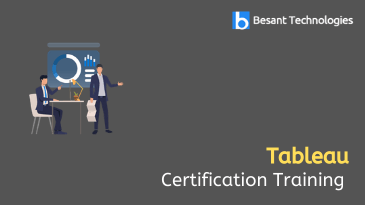Introduction to Data Visualization
Data visualization is defined as a graphical representation of data insights. The graphical representation is done by using various elements like maps, graphs, charts, and many more. It provides the best way to understand various trends in data, patterns, and outliers in data. In this section, you will learn in detail about what is data visualization, an increasing trend for data visualization, how the data visualization is done in Tableau, the advantages of data visualization, why organizations are making data visualization as their core element, and a better understanding about the elements like maps, charts, graphs, and many more.
Introduction to Tableau
Tableau is considered as one of the most prominent Business Intelligence tools that are mainly used for data visualization. It is mainly designed to provide insights into data and to develop visualization solutions. This Tableau helps you gain insights and also makes you clearly understand your data by visualizing it. Tableau is the best fit for the individual analyst, embedded analytics, and for teams and organizations. In this module, you will get through various concepts such as Introduction to Tableau, Step by step procedure to install Tableau, the importance of Tableau, Tableau interface, Data types used in Tableau, how to visualize data in Tableau Desktop, and advantages of using Tableau for data visualization.
Architecture of Tableau
Getting clear about Tableau architecture will enable you to understand the data flow in the components or chambers. You come to know how the functioning of each element happens in architecture. Tableau’s architecture is an n-tier client-server architecture and scalable that is mainly used to serve the mobile clients, installed software, and web clients. You will get through the Complete Architecture of Tableau, how to install Tableau, clear understanding about application server, knowledge about data server, toolbars, Data pane, gain good knowledge about Tableau desktop, and Tableau interface.
Data Blending and Working with metadata
Data blending provides a way to combine and define data from different sources. It is considered as the core feature in Tableau that is mainly used to analyze data from multiple sources in a single view. In Tableau, you will come across an elegant and simple metadata system called a data source. Metadata in Tableau is seamless, transparent, and approachable. In this module, you will get in-depth knowledge about excel, introduction to metadata, metadata management, introduction to SQL, various SQL operations, Unions, Joins, data extraction, gain a good knowledge of data blending, the importance of data blending in Tableau, and advantages of using data blending.
Filters in Tableau
Filters play a key role in Tableau desktop: they are mainly used to add the various interactive filters to view the field which is not visible and used in the current window or view. There are different types of filters available in Tableaus like data source filters, measure filters, and many more. In this module, you get through the types of filters available in Tableau Desktop, use of filters, the functioning of filters in Tableau, understanding about extract filters, dimension filters, context filters, types of sorting filtering in Tableau, Mark cards, how to perform sorting in Tableau, folder creation in Tableau, and advantages of using filters in Tableau Desktop
Creation of Sets
In the tableau, sets are considered as the custom fields that are mainly used to hold the subset of the data as per the given condition. Commonly in real-time, you can create set by selecting the members from the visualization or a list. You can also create a set by using custom conditions. There is a step by step procedure to create a set that mainly starts from the Data pane. You will get through the following like what is a set in Tableau, need of a set in Tableau, how to create a set in tableau, how to configure a set in Tableau, bins, constant sets, editing sets, computed sets, understanding of group and sort, sorting in Tableau, Mark cards, and Importance of sets in Tableau.
Graphs and Charts in Tableau
In this module, you will learn how to use and when to use different Tableau charts, what is a graph, what is a chart, the importance of charts and graphs in Tableau, how to visualize data using the elements like graphs and charts, different types of graphs, line graphs, Venn diagrams, pie graphs, bar graphs, how to select the type of graph which is suitable for the data, frequency histograms, figures, difference between use of charts in excel and Tableau, use of different types of charts, how both charts and graphs visualize the raw data, treemaps, waterfall charts, bullet charts, pie, bubble, funnel charts, importance of graphs and charts in Tableau, and advantages of using charts and graphs in Tableau.
Organizing Data and Visual Analytics
Visual analytics is considered a core field that is mainly used to perform visualization as per the user’s point of view to make them easily understand and use. This visual analytics uses Tableau to discuss and develop visualization. We can even navigate using Tableau and also visualize raw data in a well-defined format. How to organize data in columns and rows, how to edit excel data in Tableau manually, How to structure the raw data, how to organize data pane items in different folders, how to use formatting pane, knowledge about reference lines, how to format data using labels, K-means cluster analysis, and importance of visual analytics in Tableau.
Working with parameters
The parameter in the Tableau act as place-holder for every single global value it may be in the form date, strong, or number. Tableau parameter can be displayed as control or various options to the end-users of the desktop, dashboard, or view. This helps the end-users to have the ability to change the values of the parameters in Tableau. In this section, you will get a clear understanding of what are parameters, the need for parameters in Tableau Desktop, how to create parameters, how to make use of parameters using filters, how to use parameters in filter session, use of parameters in calculated fields, chart selection parameters, the importance of parameters in representing global value, and how to pass parameters in various sessions.
Working with Mapping
Mapping plays a key role in Tableau because if you want to analyze data geographically you can plot your data on the Tableau maps. You can connect your geographical data using Tableau mapping. In order to represent geographical data too need to prepare a hierarchy to make a basic map. Visual details are the main source that must be added to Tableau maps finally. How to plot points on images, how to make map projects in Tableau, map visualization, how to customize geocoding, WMS map, custom territories, plotting latitude and longitudes, how to edit locations, understanding of all the web mapping services, and gain in-depth knowledge about polygon maps.
Working with calculations and expressions
Tableau calculations help you to perform computations on the table values. How to create tableau calculations using a calculation editor. How to perform quick table calculations, how to create calculated fields, understand clearly about predefined calculations, how to validate different calculations, aggregation, LOD expressions, replication, different types of calculations, types of expressions in Tableau, advantages of using different types of calculations, the importance of using expressions in Tableau desktop, and different functions in Tableau.
Tableau Prep
Tableau Prep is considered as the preparation tool for personal data. This too is designed to empower the users with the ability to aggregate, cleanse, or merge the data for analysis in Tableau. It mainly comprises of two products that include Prep Conductor and Prep Builder. In this module, you will gain a better understanding of the introduction of Tableau Prep, how Prep below to clean the data for analysis, how to make use of Tableau Prep Builder to combine and shape the data, how to track operations using Prep Builder, how Prep Builder work with other Tableau products, how to install Tableau Prep Builder in Tableau Desktop, connection pane, flow pane, and how to make data preparation very simple.
Integration of Tableau with Hadoop and R
In this section, you get a clear idea about the introduction to R, introduction to Hadoop, how to deploy Hadoop on Tableau Platform, how to deploy R on Tableau platform, understand how to integrate Tableau with R, gain knowledge about integrating Tableau with Hadoop, gain in-depth knowledge about R functions in Tableau platform, how to create graphs using Tableau interface, and how to extract data from Hadoop platform using Tableau.
Dashboards and Stories
A dashboard is considered as the display of a group of worksheets in a single place. It is used to monitor and compare a variety of data simultaneously. The story is defined as a sequence of visualizations that are mainly used to work together to convey the information. Introduction to the dashboard, introduction to the story, how to create a story in Tableau, the difference between story and dashboard in Tableau, how to add a dashboard to a story in Tableau, real-time examples for Tableau dashboard, understanding about Tableau interface, gain knowledge about Tableau workspace, various Tableau field types, URL actions, how to add annotations with descriptions, how to create and update story points, various practices to create dashboards, introduction to story points, Tableau Joins, different types of joins in Tableau, understanding about various file types, and how to create interactive dashboards using actions.













